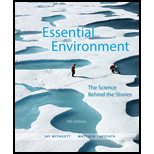
The fate of the solar radiation after it reaches Earth and also the ways by which greenhouse gases warm the lower atmosphere.
Answer to Problem 1TYC
Greenhouse gases are responsible for the cause of global warming by trapping the solar radiation and returning them back to the Earth’s surface.
Explanation of Solution
The Earth’s surface absorbs solar radiation, as it reaches Earth. The sun emits solar radiation into the land, water, and ice. The 70 % of the solar radiation is absorbed by Earth and 30 % is reflected back into the atmosphere.
Greenhouse gases are responsible for global warming because they causes the re-emission of these infrared radiation in a way in which it travels back downwards and heats the lower atmosphere.
Four factors that may influence the climate of the Earth are: the sun, the atmosphere, orbit of Earth, and the oceans. The sun releases solar energy or radiation that is absorbed by Earth’s surface, water, ice, and land. Earth absorbs about 70 % of the solar energy and 30 % of the energy is reflected back toward the atmosphere. Thus, the surface of Earth can absorb solar radiation, and the temperature gets increased and cause the emission of infrared radiation, which has longer wavelengths in comparison of visible light.
Greenhouse gases cause global warming by the process of greenhouse effect. This effect occurs when the greenhouse gases such as ozone, nitrous oxide, methane, halocarbons (CFCs), and carbon dioxide are released into the atmosphere. These gases can absorb infrared radiation.
A natural process in which solar radiation is absorbed by Earth’s surface, greenhouse gases cause the re-emission of the infrared radiation in a random way. However, some of the solar radiation is released into the atmosphere, the remaining radiation returns back to the surface of Earth and subsequently causes global warming.
Want to see more full solutions like this?
Chapter 14 Solutions
Essential Environment: The Science Behind the Stories (5th Edition)
- please do these for me and explain in detailarrow_forwardActivity 12.3: Wave Refraction Pgs 202-203Figure 12.2 is a map view of a headland along a coastline. The water depths are shown by blue contour lines. As you complete the following questions, assume that waves with a wavelength of 60 feet are approaching the shoreline from the bottom left of the figure. 1. At approximately what water depth-10, 20, 30, or 40 feet-will the approaching waves begin to touch bottom and slow down? (Hint: Recall that this occurs when the water depth is one-half the wavelength.) 2. Using the wave shown in Figure 12.2 as a starting point, sketch a series of lines to illustrate the wave refraction that will occur as the wave approaches the shore by following these steps:Step 1: Mark the position on the 30-foot contour line where the wave front will first touch bottom.Step 2: Knowing that the section of the wave that touches bottom will slow down first, sketch the shape of the wave front when it reaches the 20-foot contour line.Step 3: Using the same…arrow_forwardN Depth of water contour Advancing wave crest Beach HEADLAND -10- -20- -30' Land -40'- 50- 0 Beach Scale 200 feetarrow_forward
- Activity 12.5A: Identifying Shoreline Features Pgs 206-2081. Use the descriptions of shoreline features provided above to label the structures in Figures 12.5 and 12.6. The same feature may appear more than once. 2. Next to each of the features listed below, indicate whether it is the result of erosional or depositional processes.Sea stack:Wave-cut cliff:Spit:Barrier island:Baymouth bar:Marine terrace:arrow_forward3. Label a marine terrace, a wave-cut cliff, and a wave-cut platform in Figure 12.7. 4. Label a baymouth bar and a spit in Figure 12.8.arrow_forwardMy question: How does unequal school resources and fundings affect job opportunities for underprivileged groups? Can you go into 2. Gather facts related to your topic by using recommended Dallas College Library databases, like PubMed and Psychology Gale Academic OneFile. select important facts and statistics that will help you to answer your research question. Articles you select must be published within 5 years (2019-2024). Can you find as much articles that you can that answer my question.arrow_forward
 Applications and Investigations in Earth Science ...Earth ScienceISBN:9780134746241Author:Edward J. Tarbuck, Frederick K. Lutgens, Dennis G. TasaPublisher:PEARSON
Applications and Investigations in Earth Science ...Earth ScienceISBN:9780134746241Author:Edward J. Tarbuck, Frederick K. Lutgens, Dennis G. TasaPublisher:PEARSON Exercises for Weather & Climate (9th Edition)Earth ScienceISBN:9780134041360Author:Greg CarbonePublisher:PEARSON
Exercises for Weather & Climate (9th Edition)Earth ScienceISBN:9780134041360Author:Greg CarbonePublisher:PEARSON Environmental ScienceEarth ScienceISBN:9781260153125Author:William P Cunningham Prof., Mary Ann Cunningham ProfessorPublisher:McGraw-Hill Education
Environmental ScienceEarth ScienceISBN:9781260153125Author:William P Cunningham Prof., Mary Ann Cunningham ProfessorPublisher:McGraw-Hill Education Earth Science (15th Edition)Earth ScienceISBN:9780134543536Author:Edward J. Tarbuck, Frederick K. Lutgens, Dennis G. TasaPublisher:PEARSON
Earth Science (15th Edition)Earth ScienceISBN:9780134543536Author:Edward J. Tarbuck, Frederick K. Lutgens, Dennis G. TasaPublisher:PEARSON Environmental Science (MindTap Course List)Earth ScienceISBN:9781337569613Author:G. Tyler Miller, Scott SpoolmanPublisher:Cengage Learning
Environmental Science (MindTap Course List)Earth ScienceISBN:9781337569613Author:G. Tyler Miller, Scott SpoolmanPublisher:Cengage Learning Physical GeologyEarth ScienceISBN:9781259916823Author:Plummer, Charles C., CARLSON, Diane H., Hammersley, LisaPublisher:Mcgraw-hill Education,
Physical GeologyEarth ScienceISBN:9781259916823Author:Plummer, Charles C., CARLSON, Diane H., Hammersley, LisaPublisher:Mcgraw-hill Education,





